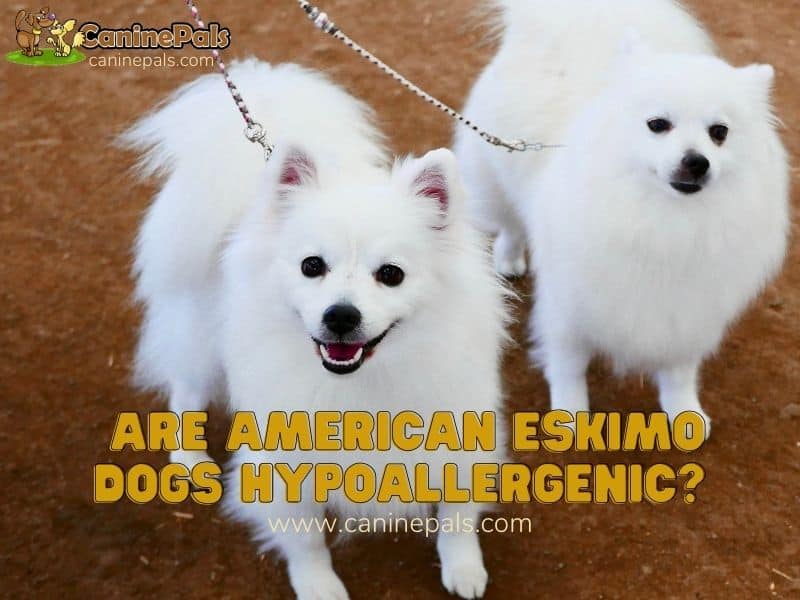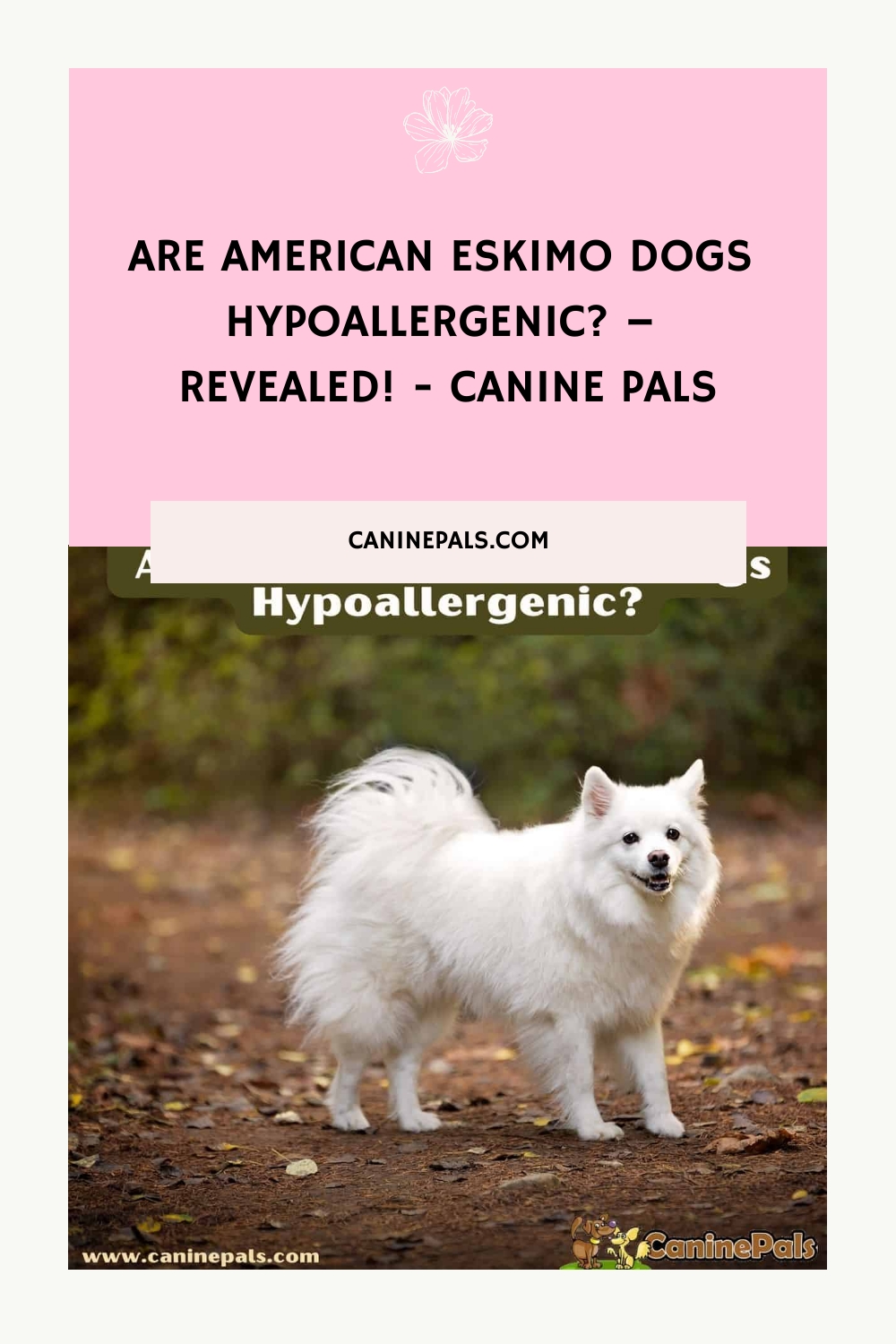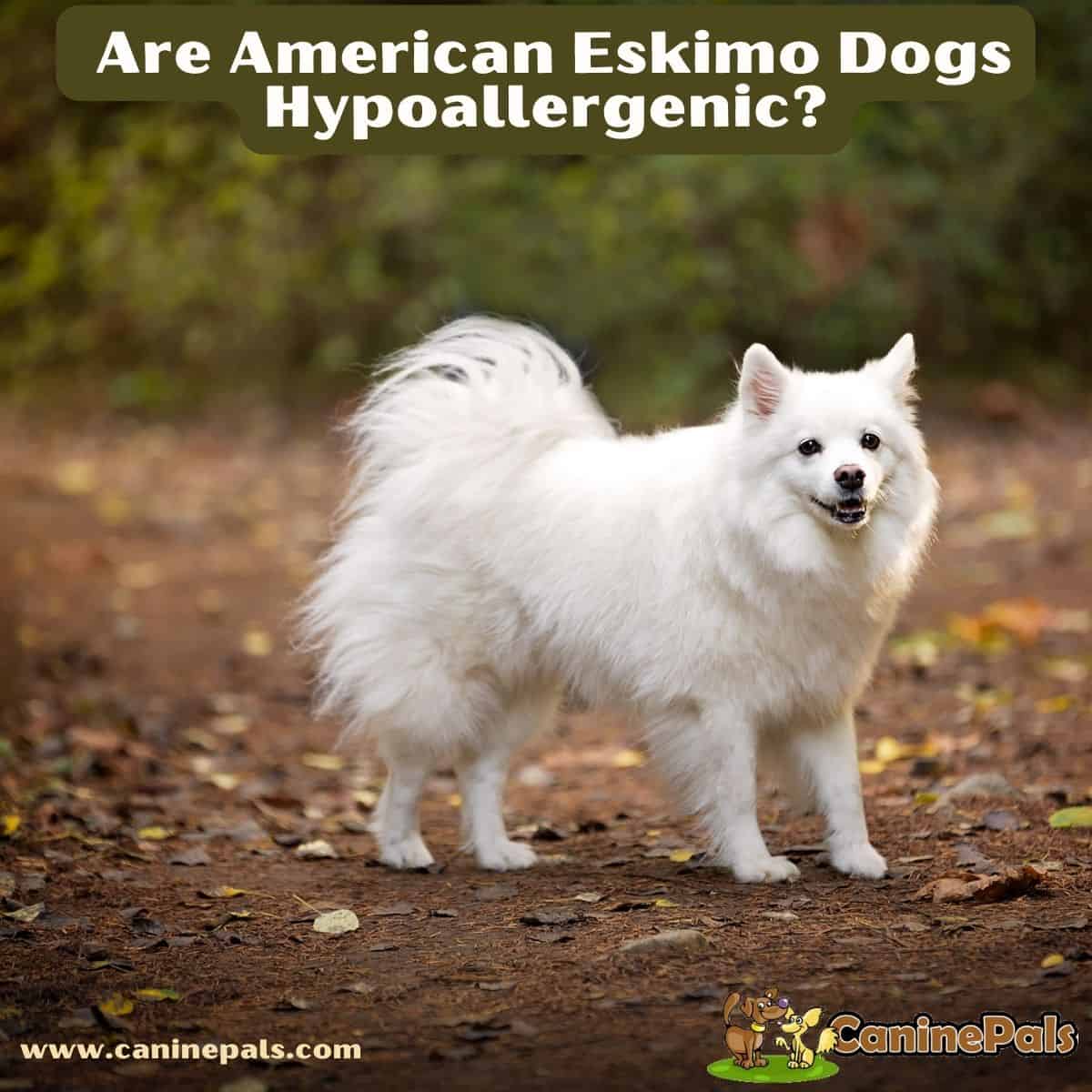Last Updated on March 27, 2024 by Denise Leo. Post first published on February 4, 2024.
When you think of buying an American Eskimo Dog wrapped in its white fur, the first thing that fascinates you is a great snuggle. After all, who doesn’t crave warm hugs from the most adorable creature on the planet? EVERYONE!
Meanwhile, you are busy daydreaming about being curled up with your cotton candy in the blanket, and a serious question pops up in your mind and bursts the bubble: Are American Eskimo dogs hypoallergenic?
You might see an assortment of misleading information related to this query online and be unable to conclude. Lucky for you, I will disclose whether your most loved American Eskimo dogs are hypoallergenic or not. Shall I?
Are American Eskimo Dogs Hypoallergenic?
The simple and quick answer to this nerve-wracking query is NO!!!
If we look at the American Kennel Club’s recommendation of Hypoallergenic dog breeds, we don’t find the American Eskimos. According to the Asthma and Allergy Foundation of America:
“In the USA alone, 3/10 people with allergies develop some kind of allergic reaction to cats and dogs. The ratio of dog allergies is, however, smaller than the ratio of cat allergies.”
Are American Eskimo hypoallergenic dogs? This question often arises among potential dog owners, especially those who are allergy sufferers. The American Eskimo Dog, often called the American Spitz, is a breed that traces its roots back to German immigrants who brought their spitz breeds to the United States in the early 1900s.
Known for their thick, fluffy white coat, black eyes, and alert expression, these dogs come in three different sizes: standard, miniature, and toy. Despite their high intelligence and versatility in dog sports, American Eskimo Dogs are not considered hypoallergenic. Their thick coat makes them heavy shedders, which can trigger allergic reactions in sensitive individuals. While their intelligence and affectionate nature make them excellent companions, those with allergies should consider this aspect carefully.
Despite the potential for triggering allergies, the American Eskimo Dog breed remains popular in the United States for its high intelligence, which makes it responsive to training and able to excel in various dog sports. It is known for its standard size, which contributes to its robust health, though, like all breeds, it can have health issues.
Their intelligence and eagerness to please also make them ideal for families and active individuals. However, allergy sufferers must spend time around the breed before bringing one into your home. While they may not be the best fit for those with severe allergies, their loyal and loving nature makes them cherished companions for many.
What is Meant by Hypoallergenic Dogs?
Hypoallergenic means something (textile, cosmetic, or pet) compatible with allergic people. Simple! A dog breed that relatively has little chance to cause an allergic reaction is said to be hypoallergenic. When you are willing to add a furry family member to your home, keeping a hypoallergenic dog breed has many perks.
Like, say:
- You and your family members (if suffering from allergies) don’t have to take anti-allergic medications or precautions.
- For a dog owner, it becomes easier for the owner to maintain the pet.
- You and your pet can enjoy a happy and healthy relationship together.

What Makes a Dog Hypoallergenic?
A dog that is 100% free of allergens doesn’t exist. Every dog can carry some allergen. The amount may differ. The main factor that plays a vital role in making a dog breed hypoallergenic is its amount of shedding.
When a dog loses his hair, shed hair contains allergy-triggering elements, such as skin cells, saliva, and urine. What allergens those fallen hairs carry depends on where those hairs are shed from.
Afterward, these loose hairs go around everywhere in your home. As a result, the allergens scatter through the air, triggering allergies. Simply put, The smallest possible amount of shedding, or no shedding at all, makes a dog hypoallergenic.
Or, you may say
The less a dog breed sheds, the more hypoallergenic it is!
Do American Eskimo Dogs Shed?
Talking about American Eskimo Dog shedding, I can only say they shed all year and seasonally. Everywhere they go, they leave their sparkling hair behind – insanely!
And, when the shedding season arrives, they shed like crazy. By shedding season, I mean the spring and the autumn months. This seasonal shedding occurs to prepare your Eskie for the upcoming season.
In spring, your American Eskimo Dog casts his hair off to change the layer of its coat that will keep him easy in the forthcoming summer. On the other hand…
Your Eskie must be fluffier in autumn to stay warm in the chilling winters. Whatever the season is to come, getting rid of their older hair becomes necessary for hairy dog breeds, like, American Eskimo dogs, to fight against the seasonal challenges.
Now, when an Eskie sheds, it can experience some dander formation on its skin. The dander builds up if your Eskimo’s skin has become dry and unhealthy. Dry skin massively provokes dander formation and can be a challenge to control.
Why are American Eskimo Dogs NOT hypoallergenic?
The same lustrous fur that makes an American Eskimo dog glamorous makes them non-hypoallergenic. The growing cycle of their fur completes fast. As soon as their hairs grow up, it gives a call to the fall-out cycle.
American Eskimo dogs have a double coat. A top coat to keep the moisture and elements at bay, and a thick undercoat to keep your furry warm in the cold weather. No doubt, it’s the beautiful coat that makes the Eskimos look adorable. But, an Eskie sheds A LOT.
When an Eskie gets rid of his older hair, it gives out some skin dander and other allergens. If you have an over-sensitive immune system and get in contact with these allergens, they’ll spark an allergic reaction. That’s why an American Eskimo dog doesn’t even come close to becoming a hypoallergenic dog breed.

Other Allergens in the American Eskimo Dog:
The main dog allergen that brings out allergies in humans is dander. Skin dander is dead skin on your furry’s coat that has become dry or unhealthy.
But as I mentioned earlier, it’s not the only issue. There are other allergens, too. These allergens—you should stay away from—are saliva and urine. You may wonder how saliva and urine can flare up allergies.
Whether it’s a non-hypoallergenic dog’s saliva or urine, both contain allergic protein that can initiate an allergic burst out. When a dog licks himself, sweats, or pees, that allergic protein ambles over the coat.
Now, when the culprit has made its way into your Eskie’s hair, it doesn’t matter how you come in contact with the allergic protein. You can interact with this allergy-causing protein directly while cuddling with your furry.
The other contact paths can be while grooming your dog, petting, or cleaning the dead hair.
American Eskimo Dog Skin Problems:
Dry skin can cause many skin problems in American Eskimo dogs. They can experience excessive scratching and irritation, which can result in infections and other skin problems, such as skin inflammation, hair loss, and hot spots.
● Hair Loss:
American Eskimo dogs need their hair to retain their body temperature, especially in cold weather. If your Eskie starts losing his hair (other than shedding), it can lead to sunburn.
● Excessive Itching:
Your dog may experience severe itching due to skin dryness or fleas. This excessive itching can further develop hot spots on your dog’s skin.
● Allergies:
Your American Eskimo dog can also face allergies. Allergies can make your dog’s skin itchy and cause hot spots.
Shaving the American Eskimo Dog’s Coat:
Many Eskimo dog owners think shaving off the Eskie’s hair is the best solution to eliminate floating Eskie hair. That’s not the way out. Really!
If you are not up for cleaning up the shedding hair, don’t go for an American Eskimo dog. Keeping an American Eskimo dog shaved is the last thing you should do. Can I shave off my American Eskie’s hair if you ask? Sure, you can.
But… Here is a catch.
Shaving off any dog’s protective coat is not recommended. When an American Eskimo dog transitions from puppyhood to adult dog, his double-layer coat grows into two layers. The layer – grows as a smooth, thick, and insulating layer.
The top layer – grows as the water-resistant guard layer over the inner layer. If you let your Eskimo’s coat grow, it will hold its wholeness as a double-layer coat. The hair shed when refurbishment is required. Other causes may be coat maintenance and temperature control.
But once you shave off your pet’s hair to the skin, it will not grow back in the same manner again—never. This happens because your Eskimo’s hair follicles do not get the signal to re-grow in the same pattern. Now, the hair growth will happen randomly, mingling and mixing the inner soft layer with the outer guard layer.
Consequently, your Eskimo dog no longer has natural protection against harsh weather. So, shaving your American Eskimo dog is a major loss. Now, you are responsible for providing your Eskie with the required protection against sunburn, windburn, pests, and more.

4 Ways to Curtail Your American Eskimo’s Shedding Hair
Shedding is one of the most important parts of ANY dog’s life. It’s a way to eliminate older hair and allow new ones to grow.
If you want a solution to stop your American Eskimo’s shedding, I am sorry, there’s none. But should this shedding thing stop you from relishing the company of an Eskie? It’s a big no-no! So, instead of finding ways to end shedding, your focus should be on how to deal with this problem.
Although there’s no proven formula, the following ways can help you reduce your Eskie’s molting.
1. Brushing:
If there is the easiest way to remove dead hair from your pet’s coat, it’s brushing. Besides clearing off the loose air, regular brushing stimulates the natural oils in your Eskie’s coat and promotes healthy fur growth.
2. Vacuuming:
If you want an Eskie at your home, investing in a good vacuum cleaner will be wise. Let the vacuum cleaner suck all the Eskie hair spread in your home. Vacuuming your house often for a proper clean-up of dog hair will keep your home tidy and save you a lot of time.
3. Bathing:
Eskies don’t require frequent bathing, but washing them up with a good dog shampoo will help clean older hair.
4. Dietary Care:
Feed your American Eskimo with a high-quality diet that comprises high-quality ingredients. Plus, try keeping a balanced dietary routine for your Eskie. To design a good diet plan, you must consult your vet.
Good nutrition will not only reduce shedding but will also nourish a healthier coat.
You may also go for some other ways to minimize your Eskimo’s dead hair. For example, administer natural shedding supplements and apply coconut oil or fish oil to your pet’s skin.

More Tips for Families with Allergies
An American Eskimo dog may cause dog allergy and other issues, but I have good news: if you can’t relinquish your desire to become an Eskie owner!
If you have mild allergies, you can own an Eskie BUT with immense precautions.
- Designate a peeing area for your Eskimo to urinate because their urine can contain allergy-triggering proteins.
- Drain out your Eskie’s energy with proper exercise and stimulation so he has no left stamina to walk around your home and spread dander.
- Grooming is the key. Schedule your Eskimo grooming sessions. Grooming helps to keep the dander and allergen build-up to a minimum.
- Always use a great quality slicker brush.
- Avoid brushing your Eskie’s coat during the shedding. Instead, use a de-shedding tool.
- Limit your dog’s access to areas where you’ll spend most of your time, like the bedroom and on the couch.
- Avoid using Eskimo in your kitchen, especially when cooking your meals.
- Wash your hands every single time you handle your Eskie.
- Including fish in your dog’s diet makes the dog’s skin healthy.
- Train your American Eskimo dog to stay in one place.
- Don’t neglect your medications, and plan medical check-ups.
Final Thoughts:
An American Eskimo dog is not hypoallergenic due to its heavy shedding. If you have an oversensitive immune system, an American Eskimo is not the dog for you. Why? If you get an Eskie, his hair will stick to everything in your home. You’ll never know where the allergen kicked off the allergic reaction—from the air? From the floor? Or from the couch.
However, if you don’t have a severe allergic problem, you can follow my tips and enjoy the Eskimo’s companionship.
The American Eskimo Dog, a member of the Spitz family, has a long history dating back to the early 20th century when German settlers brought them to the United States. Known for their striking appearance and playful nature, they have become popular circus dogs due to their high-energy disposition and intelligence.
These small to medium-sized breeds are not hypoallergenic, as their thick double coat sheds year-round, making them less suitable for allergy sufferers.
The American Eskimo Dog could be the right choice for families seeking a smart, high-energy dog. Their enthusiasm for daily runs and playtime ensures they stay in good condition, making them ideal pets for those who can keep up with their active lifestyle. Despite their small size, American Eskimo Dogs are robust and can be great companions for small children, given their playful and affectionate temperament.

Copyright CaninePals.Com. All Rights Reserved.
References and Further Reading:


